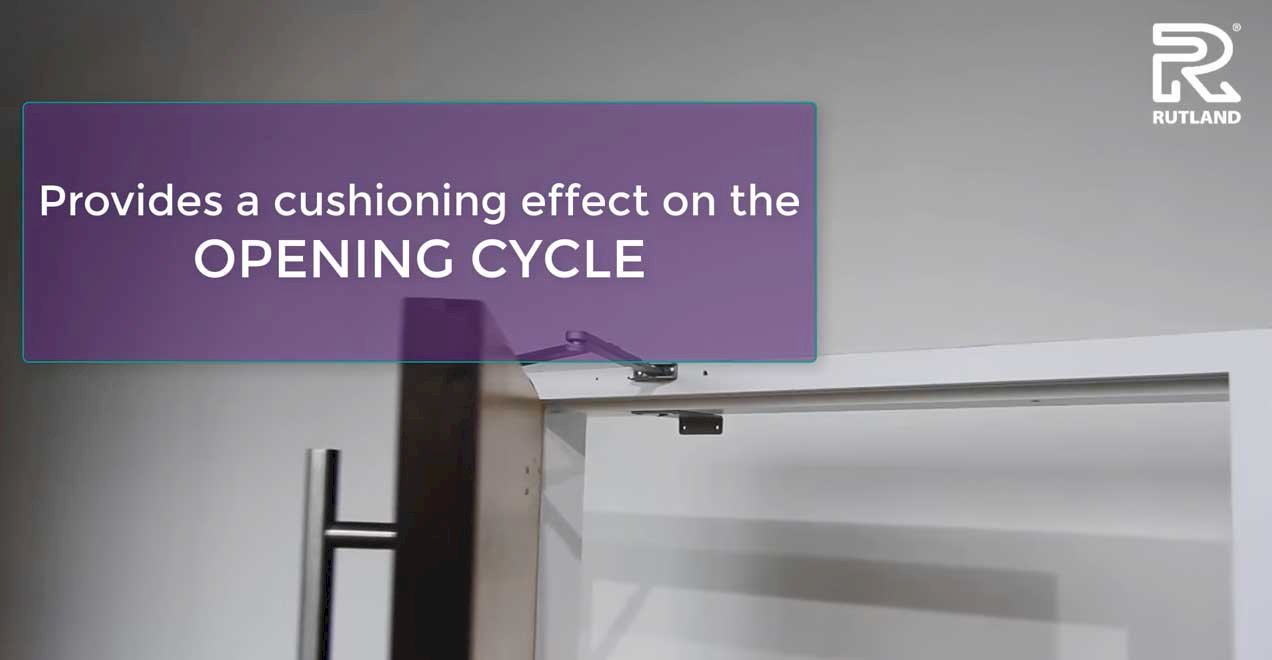
Door closers are essential safety components of a building, ensuring that fire-doors can function to protect against rapid fire or fire/smoke spread.
In addition to their basic safety functions, it is often desirable to incorporate additional features to lengthen their useful life, improve daily usability, and help further protect people and places.
One highly-valued, optional feature of door closers is the back check mechanism, which plays a significant role in controlling the speed and motion of the door as it approaches its final opening angle.
In this article, we will delve into what “back check” means on a door closer, its purpose, functionality, and how to adjust it for optimal performance.
The primary purpose of the back check feature is to protect the door, adjacent wall, the closing device itself, and people from damage or injury.
Whilst the basic function of a door closer is to ‘self-close’ the door after being pushed open, the optional back-check feature is designed to prevent the door from being opened too forcefully.
Excessive opening force can compromise the fixings that attach the closer to the door and frame, and damage the closer itself. Without a Back Check Closer or door-stop, it is very easy to damage the adjoining wall or partition by swinging the door and it's handle into it.
Back Check cushions the mechanism by absorbing excess force as it approaches the open position.
Back check on a door closer should not be confused with ‘delayed action’- which is another door closer feature that we explain in another post.
Closing devices fitted with a back-check function are highly recommended in high-traffic areas, particularly where there is less incentive to take care such as public buildings, schools etc.
Other applications where back-check closers are popular include hotels and other interiors that have an emphasis on aesthetics and user comfort, especially where heavy doors open up against wall décor, or if they lack visibility panels.
Considering the risk of doors colliding with physically vulnerable persons, such as in children’s centres or age-care homes, back check closers can offer an extra layer of user safety.
As well as areas where excessive force from users can be expected, back-check should be considered for doors subject to extreme air pressure differences and wind gusts, such as external entrance doors.
Look for Rutland door closers with the back check symbol shown, these denote the models that have this optional extra available. They include the most popular closer models of TS.5204 and TS.9205 among others.

Most back check closers use hydraulic or pneumatic resistance within the door closer mechanism. The Rutland door closer back check mechanism is a state-of-the-art sealed hydraulic system, designed for longevity and ease of adjustment.
When the door is pushed open beyond a certain point, the back check mechanism engages, slowing down the door's speed and providing resistance against excessively fast movement. This gradual deceleration towards the end of the opening phase prevents the door from ‘banging open’, allowing a gentle and safer action.
Proper adjustment of the back check mechanism is crucial for optimal door closer performance. Most door closers come with adjustable settings for back check, allowing users to customise the level of resistance according to their specific user’s needs.
To adjust the back check on a door closer, follow these general steps or watch the video below, which shows a door closer with its back check valve on the side of the closer:
1. Identify the back check adjustment valve: This is typically located on the body of the door closer and may be labelled accordingly.
2. Use a hex key or screwdriver to turn the adjustment valve clockwise to increase the back check resistance or counterclockwise to decrease it.
3. Test the door: After making adjustments, open the door and observe its movement. Adjust the back check setting further if necessary until the desired opening resistance is achieved. Consider the needs of less physically able users, who may require reduced opening resistance.
4. Fine-tune as needed: Depending on the door's weight, size, and location, you may need to fine-tune the back check adjustment to ensure optimal performance.
Watch the video below for fitting and adjusting the Rutland TS.9205 door closer. This specific closer has its adjustment valves on the front, behind the sliding face plate.
Cam Action door closers are designed for easy opening, particularly useful for ease of access requirements under ‘Doc M’ contracts. So rather than using a hydraulic back action mechanism, they can be supplied with a simple ‘cushion stop’ slide-in component, which provides an effect similar to the hydraulic back-check.
In summary, back check is a vital feature of door closers that helps regulate the opening speed and motion of doors to prevent damage and ensure user safety. Understanding how back check works and how to adjust it properly is essential for maintaining the functionality and effectiveness of door closers in various environments. By paying attention to back check settings and making necessary adjustments, users can ensure that doors close smoothly and securely every time, enhancing the overall safety and performance of fire door closers.
Leave us your contact details and we will call you back for a free consultation about your requirements.